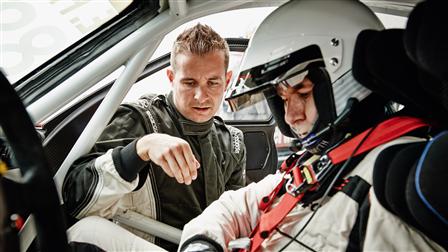
On Course
It’s the ultimate kick for anyone whose favorite hobby is racing a
The stillness heightens the tension. Wind blows softly over the grass. The
Away from the racetrack, Blessing (57) is the CEO of Dillinger Hüttenwerke, a steel-producing company in the German Saarland with a history of over three hundred years, and of Saarstahl AG. He studied economics in Constance and earned his doctorate there as well. He is at home with numbers. That fits in well with lap times. In choosing his hobbies, however, Blessing gives free rein to his emotions.
For two years now, Blessing has been entering the
Blessing is someone who places a premium on performance, in his leisure activities as well as his professional life. That’s why he is here, at the exclusive
圖庫
Blessing examines the 911 racer from a crouched position, with a respectful and even reverent air. Instructor Lauck is on his knee beside him. Lauck has the résumé of a classic race-car driver. He started with karting, and then was successful in marque cups and endurance contests. In 2006,
He starts by pulling the steering wheel out of its mount and explaining the knobs and switches to Blessing. There’s a lot of trust between the coach and his charge. You can hear it in the way they speak with each other. They have known each other for years, are achievement-oriented, and share an enthusiasm for racing.
The program for the GT3 Cup Experience includes four drives of around 15 minutes each in a Cup car, but there is room for individual adjustment. Normally the training begins in a standard GT3 so the student can get to know the course first. But because Blessing has been here often, this part is not needed.
A set part of the program, however, is that the student sits in the passenger seat for the first few laps. Lauck drives. The two can hear each other through an onboard intercom system. Driving at full speed, the coach explains the controls, shift system, braking points, and ideal line. Then he pulls over at the pit.
Blessing climbs out of the cockpit of the Cup racer—no easy task given that the helmet with its protective head-and-neck system makes it even more difficult to squeeze out of the safety cage. “Oh, I have to practice that,” he says with a grin as he walks to the other side of the car. Now, finally, the manager may climb into the driver’s seat. “Just drive at first, get used to it, and then we’ll do the fine-tuning,” says Lauck calmly. He knows about the rush of adrenaline.
“The car drives in such a playful, light, totally easy way—I wouldn’t have expected that,” exclaims Blessing after the first trip. But the instructor warns him to be careful. Blessing had already realized on his own that “without the little helpers, the Cup car drives differently than my standard 911.” Those “little helpers” are the ABS, traction control, and stability control—in other words, everything that provides additional safety to a sports car for everyday use. There’s none of that in the Cup racer, which weighs only 1,150 kilos. “It’s another type of driving,” confirms Lauck. “Braking into a curve without ABS is something completely different.”
One drive follows the next, with de-briefings and data analyses during the breaks. For a moment Blessing might think he’s back in his office, examining a balance sheet on his personal driving performance. The telemetric system mercilessly records every maneuver, and nothing will induce it to modify the results. The zigzag of the data diagrams is supplemented by video images from the onboard camera. “Look, you were quite consistent; the last two laps were just a tenth of a second apart,” says Lauck. This consistency on the ideal line distinguishes good racing drivers from those less skilled. “And here you can see that you braked very well, that’s a straight line. Brake hard, release the brakes, straighten the car, and only then accelerate—that’s the way to do it. Let’s go on to the next round!”
The
Blessing also had to get used to how the car starts up, because the clutch engages in only an extremely small range as it’s needed only to drive off and to put the gears into neutral when stopping. When driving, a light tug on the paddle switches on the steering wheel is all that is needed to change gears. It is a luxury that was not available in the previous model, when you still had to shift and double-clutch. Blessing can hardly contain himself. “Shifting with the paddles is just brilliant! And it’s an awful lot of fun.”
Blessing was a latecomer to
This exclusive training program is determined by a rhythm of driving sessions and subsequent analyses, and runs for nearly five hours. After Blessing’s final stint on the course, which lasts a good 15 minutes, the coach glances at the diagrams and gives him high marks. “Look, you’re perfect at braking. You were driving very consistently at the end and kept improving your lap times. That’s what we’re looking for.” Blessing is thrilled. “Everything is so much more immediate with this racing car. There’s nothing in between. If I pull hard on the steering wheel, the car responds. When I drive into a curve, I feel the speed of the curve in my whole body.”
But it’s enough for the moment. “You’ve got to deal with many new things all at once, and that takes a lot of effort,” remarks Karlheinz Blessing, the race-car driver.
By Eva-Maria Burkhardt
Photos Michael Haegele
Experience it yourself
The GT3 Cup Experience in Leipzig is a private qualifying for motorsports

The GT3 Cup Experience is available to
“The special thing about the GT3 Cup Experience is that you learn how to drive with a racing car,” says
Dates and registration:
cup@porsche-leipzig.com
www.porsche-leipzig.com








